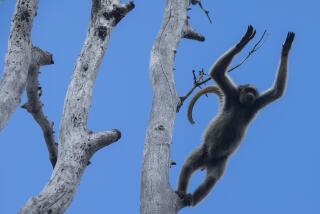Future Bleak for Madagascar’s Lemurs
- Share via
TANANARIVE, Madagascar — The first rays of sunlight pierce the swatches of mist above the leafy green roof of Madagascar’s eastern rain forests.
The cacophony of twittering birds mingles with a penetrating howling that appears to come from the lush treetops in the distance.
Maurice, the 24-year-old son of the local gamekeeper, recognizes the odd call immediately. “Those are the indris, the largest woolly lemurs on the island,” he explains.
Suddenly, a family of four indris answers a call from another group of the species about a mile and a half away. The indris, known by the natives as babakoto or amboanala, have the loudest call of the lemur family.
“There are mating calls or hedging-off cries designed to show whose territory it is,” said Maurice, who compared the lemur utterances to the jungle calls of Asiatic gibbons.
The gray and black indri, with its long hind legs, short tail and doglike head, measures about 2 feet long and belongs to a family of prosimians found only on Madagascar and the neighboring Comoro Island to the northwest.
The future for the indris looks bleak. People here are gradually destroying the lemurs’ natural habitat by chopping down the trees on whose leaves the creatures feed.
In spite of a ban, the local population is chopping down the rain forest to provide grazing land for their herds of Zebu African cattle.
The percentage of Madagascar’s 342,000 square miles given over to the rain forest has declined from 72,000 square miles (21%) in the last century to 41,000 square miles or 12% now.
As the branches vanish, so do many unique species that are only to be found on the island. Here 86% of flowering plants, 65% of birds and 99% of reptiles are native to the island.
The forefathers of the indri probably drifted from mainland Africa to the world’s fourth-largest island on natural craft made of driftwood more than 40 million years ago.
The lemurs had the place largely to themselves, since only a few other mammals managed to make the journey.
There are currently 30 types of woolly lemur on Madagascar. An estimated 12 species are thought to have died out since human beings began settling the island 1,500 years ago, including two lemur species whose representatives weighed up to 200 pounds each.
Survivors are the dwarf lemurs such as the mausmaki, or the bizarre-looking aye-aye, which uses its bony middle finger to pry insect larvae from tree bark.
The indri remains the most impressive of the lemurs. Its bushy ears, cut-off tail and howling cry have earned it an important place in Madagascan folklore.
Maurice tells the story: A young man called Koto who climbed a tree in order to collect honey was attacked by a swarm of bees and could not get away.
An indri came along and carried the youngster on his back to a safe forest clearing. Since then, the natives have dubbed the lemurs babakoto, or father of Koto.
Frenchman Pierre Sonnerat chose the scientific name indri after discovering the creatures at the end of the 18th Century. He was the first European to set eyes on them but made the mistake of christening his find after the words used by a local guide, meaning simply, “There he is.”
Not a great deal is known about the indri, whose feeding habits have not been researched by zoologists. No zoo has succeeded in keeping an indri in captivity.
Eight indris were taken to the Jardin de Plantes in Paris in 1939, but all of them died within a month, and not even the zoo here in the Madagascan capital has been able to keep an Indri alive and well behind bars.
The indri’s life style still puzzles animal behaviorists, who know for sure only that the female of the species assumes the leading role in the family groups of two to eight animals. Such female dominance is seldom found among primates.
More to Read
Sign up for Essential California
The most important California stories and recommendations in your inbox every morning.
You may occasionally receive promotional content from the Los Angeles Times.











